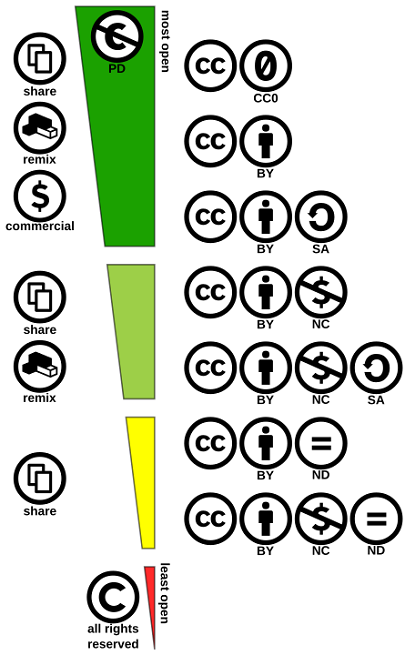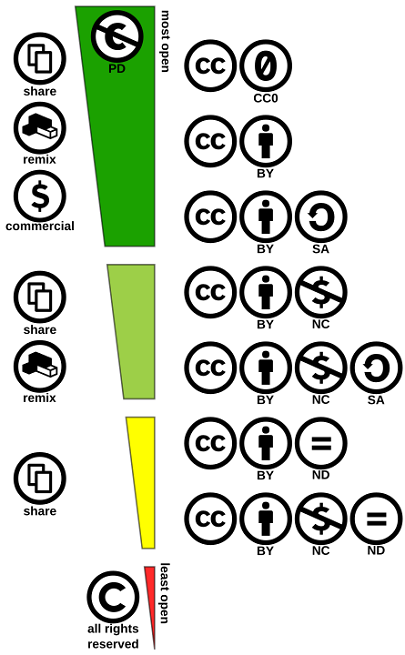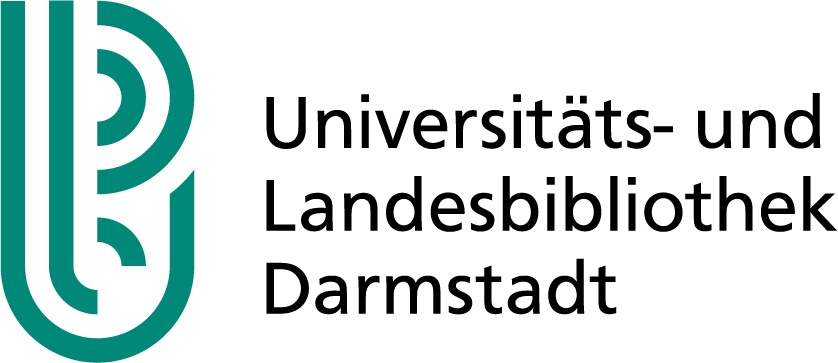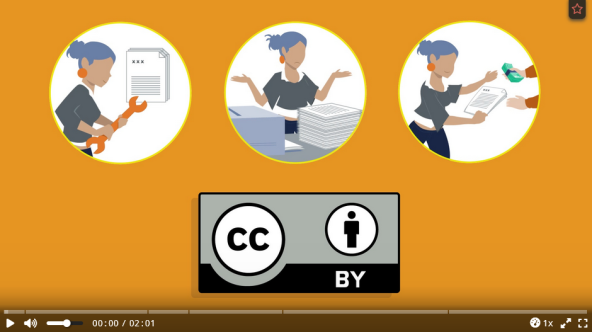Author's rights
Works are protected by national copyright and their authors have a set of inherent, exclusive rights (“all rights reserved”, German Copyright Act (Urheberrechtsgesetz)). To protect the connection between the authors and their creative works, waiving the author’s copyright is not possible in Germany (civil law tradition). Certain usage rights, however, can be transferred. Academic publishers often try to secure the exclusive rights of use for a work. After the contract has been closed, only the rights holder (= the publisher) has the sole right to distribute and publish a work and to exclude others from using it.
TU Darmstadt recommends that authors should not assign exclusive rights to publishers, but only transfer simple rights of use (TU Darmstadt's Open Access Policy (opens in new tab)).
Creative Commons licenses (CC Licenses)
CC licenses developed by the non-profit organization Creative Commons are free public licenses allowing creators to share their works under standardized terms (“some rights reserved”). With these licenses, authors have a legally secure and easy-to-understand way to share their works worldwide in compliance with national copyright laws.
Overview of CC licenses (Creative Commons)
The four license elements
| Type | Name | Description |
|---|---|---|
| BY | Attribution |
Author must be named. This element is included in all licenses. |
| SA | ShareAlike | Adaptations must be published under the same (or a compatible) license. |
| NC | NonCommercial | The use must be for non-commercial purposes. |
| ND | NoDerivatives | Subsequent users may not distribute adaptations of the work. |
The license spectrum
Only two of the six licenses are considered open access compliant. Your authorship will also be strengthened by a Creative Commons license because it means you have to be named as the author every time it is used. You can find out more about the more restrictive CC licenses in the academic context in the section “NC and ND licenses in academic publishing”. TU Darmstadt recommends the CC BY license. Non-Commercial distribution in the original state and with attribution is permitted for all license models.


Open access compliant:
Not open access compliant:
It is strongly recommended to use the latest 4.0 International version. CC licenses are copyright licenses and work on top of copyright acts, not instead of it. A license does not reduce, limit or restrain any rights under exceptions and limitations to copyright (e.g. fair use). CC licenses are enforceable worldwide and carry legal weight (Creative Commons legal database).
As a general rule, CC licenses only restrict what third parties (“reusers”) may do within the scope of the license without having to obtain your permission. As the author, you are still free to market the work commercially in parallel (even if you choose an NC license) or to grant exceptions for use that are not covered by the chosen license upon request.
The short video explains the functionality of licenses for open access (length: 1:55 min.).
Source: “Creative Commons licenses for Open Access” by Brinken et al. via TIB, CC BY 3.0 DE
Only the author has the sole right to determine the license conditions of the publication. Even if recommendations from colleagues, industry partners or long-established habits in the research group could serve as a good reference, you should choose a license yourself that covers your requirements and desired outcomes.
Support in selecting a license:
The e-learning working group of the TU Darmstadt has summarized the most important topics on legal aspects in digital teaching – copyright and citation law, Creative Commons (CC) and Open Educational Resources (OER).
NonCommercial (NC) and NoDerivatives (ND) licenses in academic publishing
The selection of restrictive licenses in academia has far-reaching consequences for the subsequent use of research results by other scientists and is generally not recommended or suitable in most academic contexts.
NC licenses
The NonCommercial (NC) element is found in three of the six CC licenses. According to the license deed, NC is defined as follows: “NonCommercial means not primarily intended for or directed towards commercial advantage or monetary compensation.” The definition is intentionally flexible.
A license with an NC element does not protect inventions, methods or facts from unauthorized commercial use. The license only protects the published work itself. Other precautions are necessary to protect intellectual property (IP) – for example, a patent application.
Usage scenarios for NC licenses can not always be clearly separated. Excluding commercial use can cause uncertainty for third parties who want to build on your work.
Case examples:
- An academic blog with banner ads uses or promotes the content.
- Educational institutions (free or fee-based courses) use the work as teaching material.
- NGOs or non-profit organizations may violate the regulations of the NC element, depending on the financing model. The same could apply to public-private partnerships.
- Authors interpret the license terms strictly and do not use NC-protected material for their own research.
NC licenses are only beneficial in the rarest of circumstances, usually in combination with the will to prosecute potential license violators. Especially in academia, this is hardly the case.The licensor loses many potential users that would in fact serve their core interest – broad distribution, widespread attention to the work or potential cooperation with other researchers, which consequently leads to more citations, better visibility and greater reputation in the scientific world.
Video “The non-commercial license in academia”
The short video explains why the use of a Creative Commons license with a non-commercial attribute is not suitable in most academic contexts (length: 2:11 min.).
Source: “The non-commercial license in academia” by Brinken et al., via TIB, CC BY 3.0 Germany
Visit these sites for more information:
ND licenses
The NoDerivatives (ND) element is found in two of the six CC licenses. According to the license deed, ND is defined as follows: “For the avoidance of doubt, You do not have permission under this Public License to Share Adapted Material.”
ND licenses prohibit sharing adaptations or derivative works of the licensed material, which means remixing, transforming, translating or updating is strictly prohibited.
A license with an ND element will not prevent other creators from using ND protected works in whole or in excerpts for collections (compilation of different works, organized as distinct separate objects) or repository deposits. If the remaining license conditions are met, this is a permitted reuse scenario, not an adaptation. Also format shifting and minor spelling corrections do not violate the ND license.
All CC license models (including CC BY) oblige potential reusers not to suggest that the author endorses or supports a particular use. Changes must be clearly marked since license version 4.0. Therefore, the choice for ND is not necessary to protect the integrity of the original material.
The ND license and the regulations embedded in copyright law will not be able to prevent material published on the Internet from being used for undesirable purposes (e.g. for extremist content or educational propaganda). You can take action against this regardless of the choice of license. The advantages of an open access-compliant license clearly outweigh the reservation of usage rights.
Disadvantages of ND licenses:
- no use for Open Educational Resources (OER), thereby limiting the distribution and attention for the work
- less or no reuse for the work of other researchers
- fewer citations and lower visibility due to the inability to adapt or edit the material
- no further development or reuse of graphics, images or diagrams to formulate new hypotheses or solutions
This will inevitably lead to less interactions within the academic community. Obtaining an individual permission is time-consuming and not compatible with the principles of open licenses.
You can find more information in this Creative Commons blog post: Why sharing academic publications under “NoDerivatives” licenses is misguided.



